From Fairchild
Tropical Botanic Garden
by Dr. Noris Ledesma, Curator of Tropical Fruit
Curator's choice
Mangos:
The Mangos of Fairchild Evolution
Noris Ledesma, a Curator of Tropical Fruit, has carefully selected
mango cultivars well-suited to contemporary conditions. These cultivars represent a new generation of mangos with superior
horticultural traits.
We
have featured mangos from the far reaches of the world; each location
with its own unique genetic mix, particular look, flavor and texture.
Our twenty two-year tour of the mango world has been full of adventure,
lore and of course taste. We have been taken to Asia and Africa, North
and South America and now we have come back to South Florida and to
Fairchild Tropical Botanic Garden. We are ready to speak of the
Fairchild “brand”. This brand celebrates the
diversity of
the fruit, as well as a future for the mango limited only by our
imagination and genetic diversity. We have well over 500 mango
varieties thriving in the Redland at the Fairchild Farm. Each variety
is unique and worthy of appreciation on its own merits. The living
collection holds the secrets of a world of mangos as well as the very
future of this fruit through each varieties unique genetic code.
Mango
Festival can hand-pick the best that we have to offer from our 600
varieties in the Living Genetic Collection. Our Mango tree selection
remains small in stature, yet produce top quality fruit. Trees are
approximately 3 ft. in height, growing in a 2 gallon plastic pot. For
your convenience, a tree holding area is available both days of the
Festival. (Sorry, we cannot pre-sell, hold or ship trees.)
2014 Curator's Choice Selections:
‘Azucar’
(Colombia)
Azucar
is widely considered the national mango of Colombia, as its flavor
speaks to the Tropical lowlands and sweet cane sugar. It is a
polyembryonic cultivar that has been savored by many generations of
children and the young at heart. The average fruit size is 220 g and
the color ranges from barium yellow to azalea pink when exposed to the
sun. The flesh is saffron yellow with coarse fiber throughout, but fret
not, for the mango is destined to be softened and sucked out of the
fruit. Azucar can be found in street markets throughout the Colombian
lowlands and can fetch high prices. The tree is easy to grow, with
consistent production and a signature flavor not to be missed.
‘Vallenato’
(Colombia)
Vallenato
is an heirloom mango from the Atlantic Coast of Colombia. The fruit has
beautiful deep vermilion red skin and is oval with an average size of
10 oz (283 g). The flesh is firm and melting, with a spicy, aromatic
flavor of citrus and apricot. It has a firm consistency that gives this
mango an exceptional storage life even without refrigeration and makes
it perfect for shipping to friends across town or on the other side of
the coutry. The tree has an open spreading canopy habit but can be trained
with proper pruning. Older trees will develop a strikingly beautiful
domed canopy. It is an early fruiting season; and there is a need to
thin fruit in most years to improve fruit size and quality.
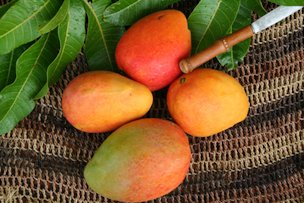
'Angie'
(Florida)
'Angie'
was selected for home garden and estate agriculture in South Florida
due to its compact growth habit, disease tolerance and overall fruit
quality. The fruit are 400 g, oblong and saffron yellow with Indian
orange blush on the sun-exposed shoulders. The skin is smooth and
without visible lenticels. The flesh is tangerine orange and without
fiber. The flavor is classified in the 'Alphonso' class of mangos with
a deep sweetness and sophisticated profile rich in apricot. The disease
tolerance is excellent and given its early season it often can be
harvested before the rainy season in South Florida. The tree is
semi-dwarf and highly manageable with annual pruning. Size can be
maintained at or below 3 m with consistent production. The tree is easy
to grow if nitrogen is kept low and the tree is not over-watered or
grown in soils prone to flooding or with a high watertable.
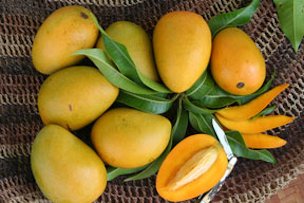
'Fairchild'
(Panama)
'Fairchild'
was selected by Dr. David Fairchild and his family in the early 1900s,
in the Panama Canal Zone. The small, oblong fruit average 10 oz. and
have lemon yellow skin at maturity in June and July. The juicy, fiber
free flesh is deep orange and aromatic, with a rich, spicy flavor.
'Fairchild' always ranks among the top cultivars in public evaluations
at Fairchild's annual International Mango Festival. The tree and fruit
are highly tolerant of disease and fruit well under humid conditions,
making it a natural for South Florida. The tree is among the most
ornamental of mangos, with its compact shape and deep green color. It
can be maintained at a height and spread of 8 ft. or less, perfect for
those with a modest-sized home garden.
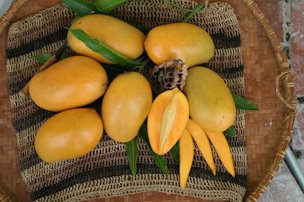
'Mallika'
(India)
Mallika
is a hybrid between Neelum and Dasheri, and is considered among the
best of the new generation of Indian dessert mangos. The tree is
semi-dwarf, making it attractive to mango growers outside of India, who
are always looking for new niche markets around the world. The bright
yellow fruit are a flattened oblong shape, with a rounded base and an
irregular, non-waxy skin. The fruit weigh from 10 to 18 oz. When
properly ripened, the pasty, but completely fiber-free flesh is a deep
orange, with an intensely sweet, rich and highly aromatic flavor.
Mallika fruit are harvested mature-green, before they break color on
the tree and should be stored at a temperature of not less than
70ºF for 2 to 3 weeks for proper ripening. In this manner their
ultimate eating quality will be achieved. The fruit can be refrigerated
after complete ripening, but not before.

'Nam Doc Mai'
( Thailand)
'Nam
Doc Mai' is among the best dessert mangos of Thailand, with an
exceptional appearance and eating quality. The fruit are long, slender
and sigmoid, weighing from 12 to 16 oz. The ripe fruit range from a
greenish- to canary-yellow, rarely with a reddish blush on the
sun-exposed shoulder. The flesh is soft and juicy, with a sweet and
aromatic flavor. 'Nam Doc Mai' has no fiber. In Thailand and throughout
much of Asia, it encompasses what is most desired in terms of
versatility and quality. It is used while mature green for dipping in
sauces and for making sweet preserves and pickles. When ripe, they have
a smooth, silky texture and extreme sweetness and bouquet. It has found
a home in the Caribbean, where it grows and fruits well.
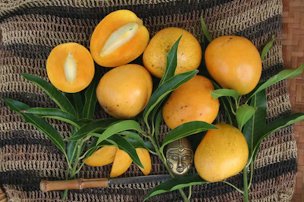
'Neelum'
(India)
Neelum
is a South Indian dessert mango, widely grown throughout the country
and to an increasing extent in southernmost China. The fruit weigh 9
oz, with a ovate-oblique shape. They are smooth-skinned and bright
yellow upon ripening and have no blush. The flesh is deep yellow or
orange. There is no fiber and a rich, aromatic flavor that is
over-powering to the unaccustomed palate. Neelum is best eaten
out-of-hand, or used as slices or cubes in mixed fruit salads, as the
firm flesh holds its shape. They have a late ripening season and can be
stored for an extended time, which offers advantages in marketing.
However, the fruit are only occasionally exported outside of their
production areas, due to significant local demand. Neelum is a dwarf
tree and may fit into modern production systems, which will hopefully
increase its availability in commercial export markets.
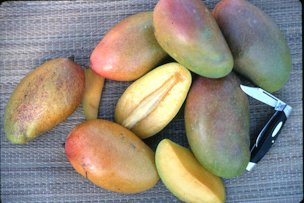
'Rosigold'
(Florida)
'Rosigold'
is a local selection of Southeast Asian heritage. It is the answer to
those who just cannot wait for the mango season to arrive, because the
fruit ripen from middle to late March. The fruit are cylindrical,
weighing 11 oz and are a bright yellow, with crimson and red highlights
on the sun-exposed shoulders. The skin is thick, tender and adhesive to
the soft, melting and juicy deep-orange flesh. The flavor is rich,
aromatic and sweet, with a hint of the Asian Tropics. There is no fiber
in the silky flesh. The tree is small, manageable and highly productive
and can be kept at 8 ft, while maintaining proper health and fruiting.
Blooming often occurs in successive waves throughout the winter,
resulting in a multi-harvest fruiting season. There is a need to thin
fruit in most years to improve fruit size and quality.
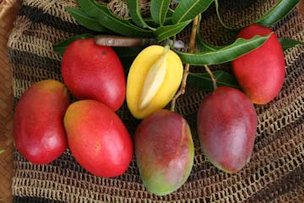
'Cogshall'
(Florida)
Cogshall
was selected on Pine Island, Florida in the 1940s for its small tree
size, good production, eating quality and beauty. It remained a local
favorite for many years, but due to the softness of its flesh, it never
became a commercial success. The fruit weigh from 10 to 18 oz. The
color is an eye-catching yellowish-orange, overlaid with a brilliant
crimson blush. The soft, completely fibreless flesh has an excellent
rich, spicy and aromatic flavor, which is sure to please even the most
finicky of mango connoisseurs. The fruit and trees have good tolerance
to fungal diseases. Fruit should be handled with care, as they are
easily damaged due to the thin skin and soft flesh. The Cogshall tree
remains small and compact and with minimal pruning can be maintained at
a height and spread of 6 ft or less. Such a tree will easily produce 30
to 40 lb (3 to 4 boxes) of fruit while retaining health and vigor. The
fruit is not available commercially outside of South Florida, and even
within this region it is extremely difficult to find.
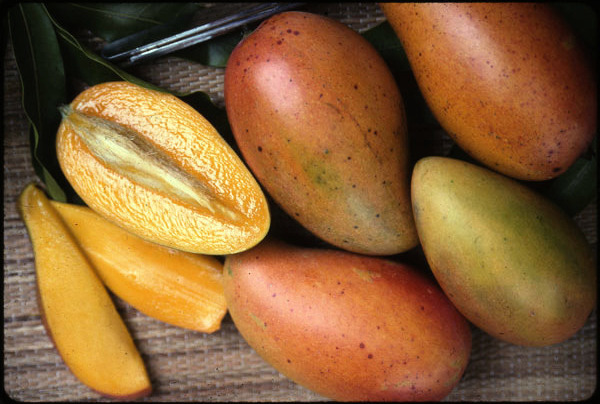
'Manilita'
(Mexico)
It
is a selection of 'Manila' from the Pacific Coast of Mexico. The fruit
are small and elongated, weighing 250 g (9 oz). The color is an
eye-catching pastel red, which covers all but the nose of the fruit.
The flesh is light yellow and silky-smooth, with a pleasing sweet and
uncomplicated flavor. It is perfect for eating out of hand, for slicing
and for dehydrating. The fruit ripen early in the mango season,
allowing the grower to have a jump on the season. It is often the
earliest red mango to ripen in Florida. The tree is dwarf and disease
resistant and is perfectly suited for container or patio production.
Tree size can be maintained at 2 m or less in height and 1.5 m in
spread. Production is not heavy, but ample harvests can be maintained
with proper care.
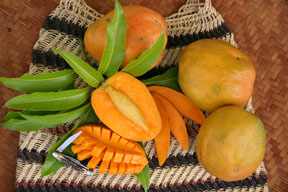
'Graham'
(Trinidad)
Graham
is a descendent of Julie selected in Trinidad. The fruit are oval, with
a flattened base and a rounded apex, ranging in weight from 16 to 29
oz, with an average of 1.3 lb. The stem is petite and set in a shallow
depression, reminiscent of Julie. The fruit ripen from mid-July to
August to a bright yellow, rarely with a slight pink blush. The skin is
thick and tough and tolerant of rough handling. The flesh is completely
fibreless, deep orange, soft and juicy with a sweet, rich and aromatic
flavor. During the late summer, a finer-flavored mango would be hard to
locate. Graham is similar to Julie, both in its growth habit, and fruit
shape. The tree, however, grows better in moist, humid conditions,
typical in South Florida. The tree is compact, and with annual pruning
can be maintained with a size and spread of 8 ft or less, perfect for
the space-limited homeowner. The fruit are larger than Julie and
fruiting is more dependable. There will be less headaches in growing a
Graham and more time eating this fruit.
Back to
Mango
Page
|
|








